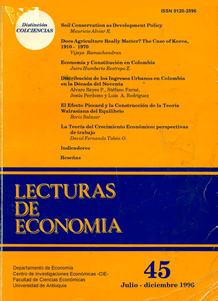Distribución de los ingresos urbanos en Colombia en la década del noventa
DOI:
https://doi.org/10.17533/udea.le.n45a4956Abstract
A principios de los años noventa se presentó una aguda polémica, con respecto a la evolución reciente de la distribución de los ingresos en Colombia. Parte del debate se centró en el problema del censuramiento, es decir: la imposición de un tope máximo al registro de los ingresos en las encuestas de hogares. El presente artículo se enmarca de esta discusión y aplica la metodología de Pareto para solucionar el problema del censuramiento. Se construye una serie de índices de Gini entre 1990 y 1995, los cuales muestran un fuerte deterioro de la equidad hasta 1993 y una leve mejoría entre 1993 y 1995, en los siete principales centros urbanos del país. Al parecer, lo acontecido en estos años, en el mercado laboral, ha tenido más influencia sobre este resultado que la misma apertura económica.
Downloads
Downloads
Published
How to Cite
Issue
Section
License
This page, by Universidad de Antioquia, is licensed under a Creative Commons Attribution License.
Authors who publish with this journal agree to retain copyright and grant the journal right of first publication, with the article licensed under a Creative Commons Attribution-NonCommercial-ShareAlike License allowing others to share it as long as they acknowledge its authorship and original publication in this journal.
Authors can enter into separate, additional contractual arrangements for the non-exclusive distribution of the journal's published version of the work (e.g., post it to an institutional repository or publish it in a book), provided that these arrangements be not for profit and the journal be acknowledged as the original source of publication.
Authors are permitted and encouraged to post their papers online (e.g., in institutional repositories or on their websites), as it can lead to valuable exchanges as well as greater citation of the published work.







